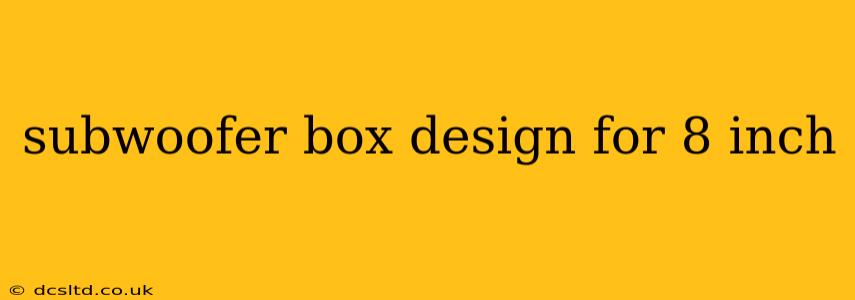Choosing the right subwoofer box is crucial for achieving optimal sound quality from your 8-inch driver. A poorly designed enclosure can significantly hamper performance, resulting in muddy bass, lack of extension, or even driver damage. This guide will walk you through the key considerations and steps involved in designing a subwoofer box for your specific 8-inch driver. We'll cover everything from choosing the right enclosure type to calculating the internal volume.
What Type of Enclosure Should I Use?
This is perhaps the most important decision. The type of enclosure significantly impacts the subwoofer's sound characteristics. The most common types include:
-
Sealed (Acoustic Suspension): Sealed enclosures are simple to build and offer tight, controlled bass. They are less prone to port noise and generally have a more linear frequency response. However, they typically produce less overall output compared to ported designs.
-
Ported (Bass Reflex): Ported enclosures use a port (tube) to enhance bass output at specific frequencies. They can achieve higher output levels than sealed enclosures, but the tuning frequency is critical and needs precise calculation. Poor tuning can lead to a "boomy" sound or reduced efficiency.
-
Bandpass: Bandpass designs are more complex and offer highly tuned bass response within a specific frequency range. They require precise calculations and are generally not recommended for beginners.
-
Passive Radiator: Similar to a ported design, but uses a passive radiator (a woofer without a magnet) instead of a port. This often results in a smoother, more controlled bass response compared to a ported enclosure.
What are the Key Design Parameters?
Several factors influence subwoofer box design:
-
Driver Specifications: The most crucial information comes from your 8-inch subwoofer's specifications. You'll need the driver's Vas (equivalent compliance volume), Fs (resonant frequency), and Qts (total Q factor). These parameters are usually found in the driver's datasheet. Without these, accurate design is impossible.
-
Enclosure Volume: This is the internal volume of the box, calculated based on the driver's parameters and desired enclosure type. Incorrect volume can lead to poor performance.
-
Tuning Frequency (for ported enclosures): This determines the frequency at which the port resonates. It influences the overall bass response and should be carefully selected.
-
Port Length and Diameter (for ported enclosures): The port's dimensions are directly related to the tuning frequency and the enclosure volume.
How Do I Calculate the Enclosure Volume?
The calculation of the enclosure volume depends heavily on the chosen enclosure type (sealed, ported, etc.) and the driver parameters. There are numerous online calculators and software programs available that simplify this process. Many reputable speaker design websites offer these tools; searching for "subwoofer box calculator" will yield plenty of results. Inputting your driver's specifications accurately is paramount.
What Materials Should I Use?
Common materials for subwoofer box construction include:
-
Medium-Density Fiberboard (MDF): A popular choice due to its density and stiffness, minimizing unwanted vibrations.
-
Particle Board: Less expensive than MDF but may require more bracing for rigidity.
-
Plywood: Offers good strength but can be more expensive and more difficult to work with.
How Do I Choose the Right Port (for Ported Enclosures)?
For ported designs, the port's length and diameter are crucial for accurate tuning. Again, online calculators can help determine these parameters based on the desired tuning frequency and enclosure volume. The port material should be rigid and non-resonant to avoid unwanted noise.
H2: What is the Best Subwoofer Box Design for an 8-Inch Subwoofer?
There's no single "best" design. The optimal design depends entirely on your preferences (tight bass vs. powerful bass), the listening environment, and, most importantly, your 8-inch subwoofer's specifications. A sealed enclosure is a good starting point for beginners due to its simplicity, while a ported enclosure can offer greater output but requires more precise calculations.
H2: Can I Build a Subwoofer Box Myself?
Yes, many enthusiasts successfully build their own subwoofer boxes. However, it requires some woodworking skills and careful attention to detail. Accurate measurements and precise construction are essential for achieving optimal results. Many online tutorials and resources are available to guide you through the process.
H2: What are the Common Mistakes to Avoid When Designing a Subwoofer Box?
-
Incorrect Driver Parameter Entry: Using incorrect driver parameters in your calculations will result in a poorly performing subwoofer. Double-check your numbers!
-
Poor Construction: Using flimsy materials or inadequate bracing will lead to unwanted vibrations and reduced sound quality.
-
Neglecting Internal Bracing: Internal bracing helps to strengthen the box and reduce resonance.
-
Improper Port Design (for ported enclosures): Incorrect port dimensions will lead to poor tuning and undesirable sound characteristics.
By carefully considering these factors and utilizing online resources and calculators, you can design and build a subwoofer box that will allow your 8-inch driver to perform at its best. Remember, accuracy is key throughout the entire process, from gathering your driver's specifications to constructing the enclosure. Happy building!
